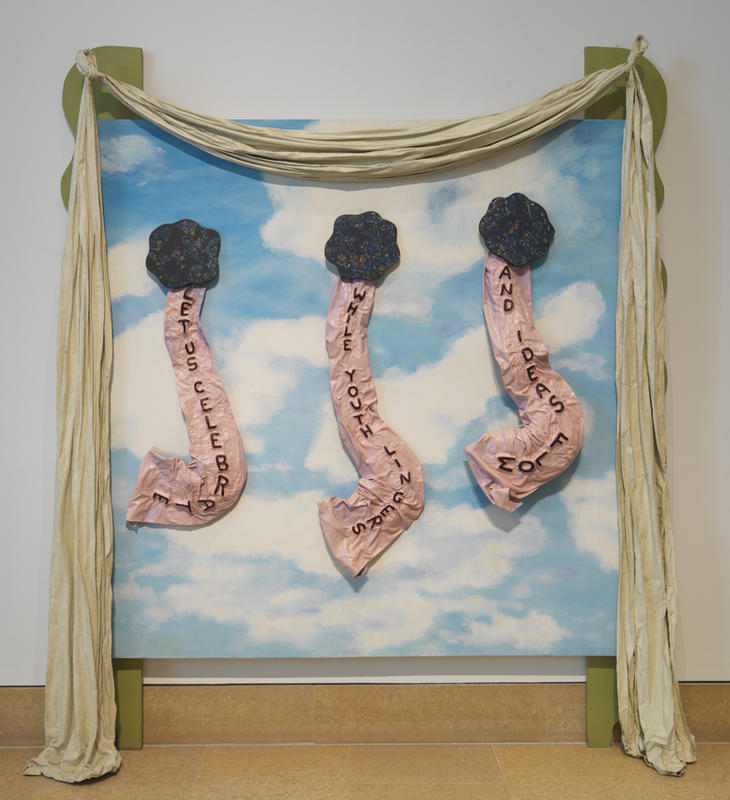More about Let Us Celebrate While Youth Lingers and Ideas Flow

Sr. Contributor
Ree Morton’s story feels like what would have happened if the main character from "The Yellow Wallpaper" became an artist who collaged with the wallpaper that was driving her crazy.
Morton was a housewife and mother who was unfulfilled with the banality of her domestic life. She described her own experience as a “feminist classic,” in which she found her true self through making art. When she started her art career, Morton was responding to not only her social status, but also to the current trends in the art world. In the 1960s and ‘70s, Morton was inundated with the work of minimalist artists like Donald Judd. Morton was one of a few brave artists who challenged the dominating trend of making grandiose statement pieces with the fewest and barest materials possible.
In an innovative response to minimalism, Morton used many of the visual cliches from her former life as a middle-class homemaker. Her work is awash with flowers, frills, and fantasy. But Morton wasn’t just taking a stab at artists like Judd. She was inserting her autobiographical narrative, allowing her personal experiences to flow seamlessly into her artworks, while also establishing them as universal messages with which other women could identify. These themes pointed Morton in the direction of stereotypically feminine imagery and allowed her to freely play with the ideas and techniques of craft and decoration in the realm of serious fine art. She worked with the tropes of motherhood and femininity to explore what it meant to be an artist who was also a woman and a mother.
As an early installation artist whose work revolved around the idea of the feminine, Morton became increasingly interested in the tactile nature of the materials that she used, as well as the larger meanings that these materials signified. The idea of materiality was also embraced by her contemporaries, like Eva Hesse. Morton’s use of autobiographical narratives also paved the way for future feminist artists. Had Morton not claimed her life's narrative as a valid subject for art, future works like Tracey Emin'sMy Bed would probably not have come to be.
As Morton continued to grow her artistic practice, she began to work with a material called celastic. You can usually find it in the seemingly freeze-dried curtains that frame many of her works. Although these draperies recall the images and materials associated with funerals, Morton also used them to memorialize and celebrate the moments of her life. The duality between life and death, as well as celebration and mourning, are prominent in her work, especially in this piece that eerily seemed to premeditate Morton’s early death in a car accident at the age of 40.
Sources
- Gregory, Alice. “What Does It Mean to Be an Artist and a Mother?” T Magazine. 29 August 2018, The New York Times. https://www.nytimes.com/2018/08/29/t-magazine/ree-morton-artist-mother…. Accessed 3 January 2022.
- Haddad, Natalie. “Ree Morton’s Personal Work Asserts That Art Doesn’t Exist in a Vacuum.” Reviews. Hyperallergic. 16 July 2020. https://hyperallergic.com/576981/ree-morton-the-plant-that-heals-may-al…. Accessed 3 January 2022.
- Institute of Contemporary Art, Los Angeles. “Exhibition Didactic for Ree Morton: The Plant That Heals May Also Poison.” Exhibitions. https://cdn.filepicker.io/api/file/RsSCkT8yRzWh6SouZBYH. Accessed 3 January 2022.
- New Museum. “Ree Morton: Retrospective 1971 – 1977.” Archive. Exhibitions. https://archive.newmuseum.org/exhibitions/21. Accessed 3 January 2022.
- Pennsylvania Academy of Fine Arts. “Let Us Celebrate While Youth Lingers and Ideas Flow.” Collection. https://www.pafa.org/museum/collection/item/let-us-celebrate-while-yout…. Accessed 3 January 2022.











